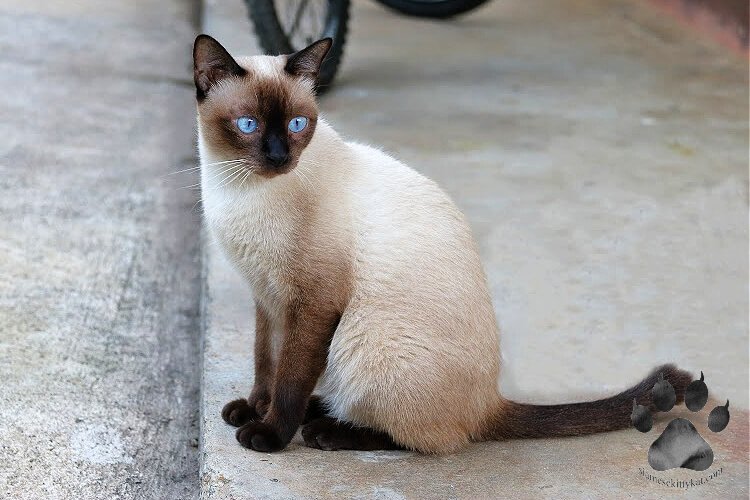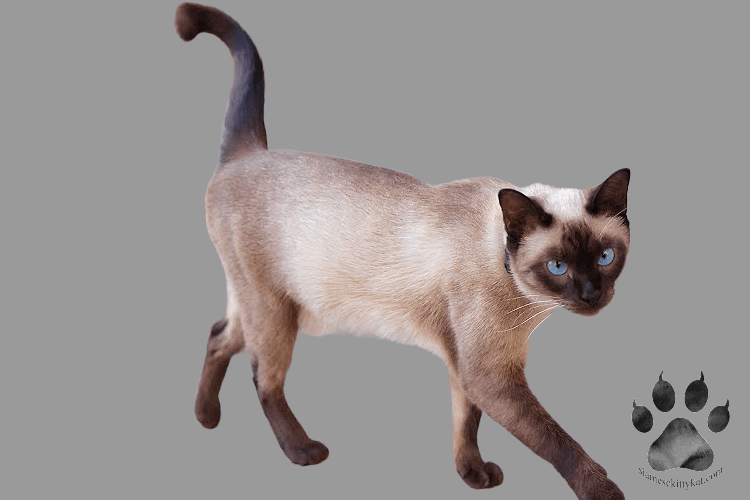I’m sure you’ll agree that Siamese cats are one of the most fascinating felines. One thing that mystifies most cat owners is the movement of our furry friend’s tail.
I, for one, have often wondered why a Siamese cat wags its tail and what it could mean. That’s why I’m excited to explore why Siamese cats wag their tails.
You’ll be able to connect with your furry friend even more by understanding this behavior.
So let’s dive in!
What Does a Cat Wagging Its Tail Mean?
Tail wagging in cats is not the same as tail wagging in dogs. Dogs often wag their tails to display excitement or happiness. Cats have a more complex range of tail movements that convey various emotions.
Here are some possible meanings behind your cat’s tail wagging:
1. Playfulness
Tail wagging can be a sign of playfulness in cats. A cat ready to play may exhibit a quick tail wag or even puff up its tail like a bottle brush. This is an excellent sign that your cat is in a playful mood and ready for interactive fun.
2. Curiosity
Cats will wag their tails slowly when they’re feeling curious about something. This could be a new object in the room, a strange noise outside, or even another animal they’re trying to understand.
3. Health Issues
Tail wagging in cats can signal an underlying health problem, such as pain or discomfort. See your vet if your cat is consistently wagging its tail abnormally or if the tail is limp or unresponsive.
4. Breed-specific behavior
Certain breeds, like the Siamese and Abyssinian, are known for
being more expressive than others. Tail wagging is more prominent in these breeds and may be used to express their lively personalities.
5. Personal quirk or habit
Some cats may have a habit of wagging their tails, like some people twirl their hair or tap their feet. This kind of tail-wagging may not necessarily have any deep meaning.
Tail wagging could be a unique and endearing trait that adds to your cat’s charming personality.
6. Pleasure
Tail wagging can be a sign that your cat is happy and relaxed. They feel content and comfortable if they’re purring or kneading while wagging their tail.
7. Excitement

Your cat wagging his tail quickly and low to the ground mean that they’re excited or stimulated. This could be with playtime, food, or seeing their favorite human walk in the door.
I was always fascinated with Robyn, my beautiful Siamese cat. She had a particular way of expressing her confidence and happiness – by wagging her tail!
Robyn would wait for me at the door, meowing and purring whenever I came home from work. She wagged her tail as soon as I picked her up and gave her some cuddles. It was a gentle, relaxed gesture that let me know she was happy to see me.
8. Fear or frustration
Aggressive tail wag can indicate fear or frustration. It’s best to give them space if your cat’s ears are pinned back, and their body language is tense.
9. Communication
Tail wagging can be a way for cats to communicate with other cats, animals, or even humans. It could also be a sign of dominance or submission.
Why Do Siamese Cats Wag Their Tails While Lying Down?
Cats use their tails to communicate their moods and intentions to other animals, including humans.
Your Siamese is telling you his feeling good and at ease if he’s lying down and wagging his tail.
There could be other reasons for the tail wagging while lying down. For example, your Siamese cat might be experiencing a sensory overload or taking in their surroundings.
Pay attention to their body language and behavior to ensure that
they’re not feeling uncomfortable or stressed.
But as long as your Siamese cat is lying down and wagging their tail
calmly and casually, you can rest assured that they’re in a good
mood.
Is a Siamese Cat Angry When It Wags Its Tail?

A Siamese cat wagging its tail doesn’t necessarily mean they’re angry. Cats don’t have a universal language like humans do. You’ll have to pay attention to other cues to determine their feelings.
Tail wagging is only one piece of the puzzle.
In fact, Siamese cats can wag their tails for a variety of reasons.
Sometimes they wag their tail when they’re excited or curious, like when they see a toy or hear a noise. Other times, they wag their tail when relaxed, especially if they’re curled up in your lap.
However, your Siamese cat might feel agitated or defensive if he’s tail wagging is accompanied by hissing, growling, or swatting.
This is common if they feel threatened by another animal or are in unfamiliar territory. It’s best to give your cat space and approach them cautiously in these cases.
But your cat’s likely feeling happy if he’s wagging his tail while playing or cuddling with you. Tail wagging in these situations is a sign of excitement and joy. They might even wag their tail while they’re purring.
All in all, tail wagging is not a definitive sign of just one emotion in Siamese cats. It’s just one of the many ways cats express themselves.
Be observant and try to understand your feline friend’s mood through their body language. Remember, it’s better to approach them gently and cautiously when in doubt.
Do Siamese Cats Like It When You Touch Their Tail?
Siamese cats have unique preferences and boundaries. Some might love touching and playing with their tail, while others may not enjoy it as much.
Observing their behavior and body language lets you tell if your cat is enjoying the tail touch. It’s a good sign they’re enjoying the interaction if they seem relaxed, content, and even playful while you’re touching their tail.
On the other hand, your Siamese cat may flick its tail aggressively or even try to move away from you if he’s not keen on touching their tail. She may have a tense posture or look uncomfortable.
These behaviors can signal that they’re not liking the interaction.
It’s essential to respect your cat’s boundaries and preferences. Remember, like humans, cats have different personalities and quirks. Some enjoy attention and affection, while others prefer more independent time.
Try to find other ways to show them love and attention if your Siamese cat doesn’t enjoy tail touching. Petting them on their head or stroking their back are other options.
Why Does My Cat’s Tail Go Up When He Sees Me?
A raised tail on a Siamese cat when they see you is a good sign! It means your cat is excited, happy, and comfortable with your presence.
Siamese cats are known for being particularly social and affectionate with their owners. Seeing that raised tail is definitely a warm welcome.
Here are a few reasons why your Siamese cat’s tail goes up when they see you.
- It could be a sign of happiness and contentment. The slow, gentle raising of the tail, often accompanied by purring, indicates that your cat is relaxed and happy to see you.
- Another reason could be anticipation. Siamese cats are curious creatures and love to be active. A more rapid and lively tail-raising could indicate that your cat is anticipating some playtime or other fun activities with you. So, give your Siamese cat plenty of attention and stimulation to keep them entertained.
- Recognition is also a possibility. Your Siamese cat might acknowledge you as their owner and show their loyalty towards you.
Siamese cats are known for their strong bonds with their owners. It’s no surprise that they show excitement and happiness at the sight of you.
- Your cat might be raising their tail to get your attention. Giving your cat extra attention might be a good idea if your little companion keeps staring up at you with her tail held high.
A raised tail on a Siamese cat is a positive and endearing behavior. It’s a sign that your cat loves and is happy to see you. So the next time your furry friend greets you with a raised tail, know it’s their way of saying, “Hello, I love you.”
Want to immerse yourself more in the captivating world of Siamese cats? I’ve got all the information you need from their distinct color points to their fun personalities: Siamese Cats: Unique Features and Personality
